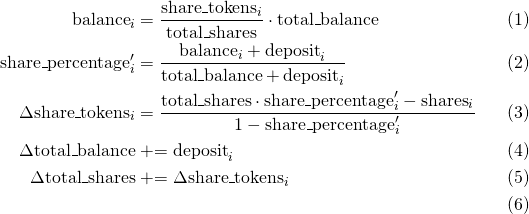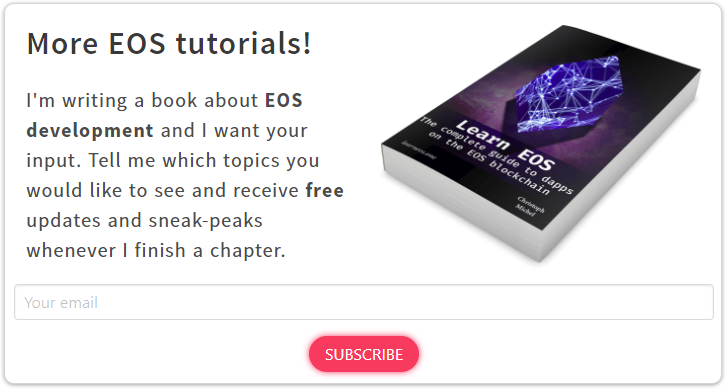Implementing efficient Dividend tokens
A blockchain makes it possible to distribute ownership of a product and its funds to thousands of individuals in a verifiable way. For example, casino dapps might crowd-source the funds required for the house party and in return distribute all profits back to the supporters proportional to their share in the total house funds. Similarly, on EOSIO users can lend their CPU from staked EOS tokens to the resource exchange (REX) and earn their share every time someone takes a CPU loan from REX.
To make this profit-sharing trustless and verifiable it must be implemented in a smart contract. The challenge is that this must be done efficiently as we want to support hundreds of thousands of users. (REX on EOS mainnet currently has 22,282 REX holders).
This post explains how to implement efficient dividend tokens. Instead of just showing the final result, we’ll begin by exploring and gradually improving upon previous ideas. It’s an important skill that I think is not taught enough.
Storing the balance per user
The simplest way would be to just store the balance per user at each time. Assume there are 4 users depositing 10 TOKENS each.
| User | Balance | % Share |
|---|---|---|
| 1 | 10 | 25% |
| 2 | 10 | 25% |
| 3 | 10 | 25% |
| 4 | 10 | 25% |
Total Balance: 40.
If there’s a profit of 20 TOKENS, it should be split in a way that each user receives the appropriate share of 5 TOKENS.
The new balance for user i is computed as:
The updated balance looks like this:
| User | Balance | % Share |
|---|---|---|
| 1 | 15 | 25% |
| 2 | 15 | 25% |
| 3 | 15 | 25% |
| 4 | 15 | 25% |
Total Balance: 60.
This requires iterating through all users whenever there is a profit to be shared. One could mitigate this by letting the profits accumulate in a pool and only periodically distribute the funds. However, as we’ll see there are better options.
A useful insight at this point is that while the absolute balances for each user change with each profit distribution, their percentage in the total share stays constant. Their share as a percentage only changes when a user makes a deposit or withdrawal.
Requirements:
- Requires storing the users’ balances, and the total sum of balances of all users.
- Profit distribution: Requires iterating over all users.
- Deposit / Withdrawal: Requires only changing that user’s balance and the total amount.
Storing the percentage of total share per user
Assuming profit distributions occur more frequently than users joining/leaving the system, using the previous insight we can implement a more efficient scheme by storing each user’s share percentage instead of the balance. This improvement is useful for casinos where a profit distribution can happen with each bet.
| User | % Share | (Available Balance) (not stored) |
|---|---|---|
| 1 | 25% | (10) |
| 2 | 25% | (10) |
| 3 | 25% | (10) |
| 4 | 25% | (10) |
Total Balance: 40.
When a profit happens, we don’t need to do anything because the profit is distributed proportionally to each user’s share anyway, meaning each user’s share remains the same. Only if you actually wanted to transfer the profit to each user you would need iterate over all users and recompute the values. The same is true for deposits and withdrawals for users because they are in itself just transfers of funds.
Requirements:
- Requires storing the users’ share percentages, and the total sum of balances of all users.
- Profit distribution: Nothing to update.
- Deposit / Withdrawal: Requires changing the share percentage of each user and the total amount.
Creating a dividend token
Both previous approaches still require iterating over all users when either distributing profits or when doing a single withdraw / deposit. We can avoid this by introducing a new token. This token represents the share of funds belonging to the user - proportional to the total token supply.
With the previous example as our baseline, the initial number of share tokens each user has is just the same as the actual share percentage.
In reality, when starting from an initial state of no users, one simply picks a specific amount of initial share tokens to issue. The actual number does not matter.
| User | Share Tokens | (% Share) (not stored) | (Available Balance) (not stored) |
|---|---|---|---|
| 1 | 25 | 25% | (10) |
| 2 | 25 | 25% | (10) |
| 3 | 25 | 25% | (10) |
| 4 | 25 | 25% | (10) |
Total Balance: 40. Total Shares: 100
As the share token just represents the share, it shouldn’t change when new profits are distributed as we have seen that each user’s individual share (percentage) remains the same. We could achieve the same with the previous approach of just storing the percentage directly, but introducing a share token allows us to only update a single user upon deposits/withdraws. Let’s assume user 4 deposits 10 more value tokens:
| User | Share Tokens | (% Share) (not stored) | (Available Balance) (not stored) |
|---|---|---|---|
| 1 | 25 | 20% | (10) |
| 2 | 25 | 20% | (10) |
| 3 | 25 | 20% | (10) |
| 4 | 50 | 40% | (20) |
Total Balance: 50. Total Shares: 125
The only thing that changed with a deposit is the share tokens for user 4, the share tokens for every other users did not need to be updated.
Note how the each users’ share tokens divided by the total share tokens still equals their share percentage.
This fact allows us to come up with a formula for the number of new share tokens that need to be issued (Δshare_tokens) for the user:
All variables can be computed from the total token amounts and the individual share tokens of the users.
share_percentage_i' = (10 + 10) / (40 + 10) = 2/5 = 0.4
Δshare_tokens = (100 * 0.4 - 25) / (1 - 0.4) = 15 / 0.6 = 25Meaning, 25 new share tokens need to be issued to user 4 in order for the share tokens to represent the new share percentage. The same computation should work for withdrawals by considering negative deposits.
The reason why we could save on recomputing the share percentage of all users is that issuing new tokens for a single user also adjusts the baseline, the total amount of share tokens. (The baseline for the inflexible share “percentage” computation always had to remain at 100 and thus required recomputation for every user.)
Introducing the share token allows implementing very efficient distributed dividend tokens that only require updating a single user.
Requirements:
- Requires storing the users’ share token amounts, total share tokens, and the total sum of balances of all users.
- Profit distribution: Nothing to update.
- Deposit / Withdrawal: Requires changing the share percentage of a single user and the total amounts.




